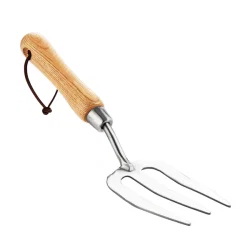Key features and common uses of a garden fork
2024-03-12
A garden fork is a versatile tool used for various tasks in gardening and landscaping. It typically consists of a handle attached to several sturdy, pointed tines. Here are some key features and common uses of a garden fork:
Features:
1. Tines: The primary feature of a garden fork is its tines, which are pointed and sturdy prongs that extend from the handle. The number of tines can vary, but garden forks typically have four to six.
2. Material: Garden forks are commonly made from materials such as stainless steel, carbon steel, or aluminum. Stainless steel is known for its resistance to rust, while carbon steel is durable and robust.
3. Handle: The handle of a garden fork is usually made of wood or metal. Wood handles provide a traditional and comfortable grip, while metal handles may offer increased durability.
4. Grip: Some garden forks have ergonomic grips or cushioned handles to enhance comfort and reduce hand fatigue during prolonged use.
Common Uses:
1. Turning Soil: One of the primary uses of a garden fork is turning and aerating the soil. By inserting the fork into the soil and lifting, you can break up compacted earth, improve drainage, and introduce air to the root zone.
2. Loosening Soil: Garden forks are useful for loosening soil in preparation for planting or transplanting. They can be used to break up clumps of soil and create a loose, friable texture.
3. Lifting and Turning Compost: When turning compost piles, a garden fork is effective in mixing and aerating the materials. It helps speed up the decomposition process and ensures even distribution of nutrients.
4. Removing Weeds: The pointed tines of a garden fork make it useful for removing weeds from the garden bed. By inserting the fork near the base of the weeds and lifting, you can loosen the roots and pull them out.
5. Lifting and Dividing Plants: Garden forks are handy for lifting and dividing perennials or other plants. By carefully inserting the fork into the soil around the plant and gently lifting, you can separate root systems.
6. Mixing Soil Amendments: When incorporating compost, mulch, or other soil amendments, a garden fork can help mix them thoroughly into the existing soil.
7. Harvesting Root Vegetables: Garden forks are suitable for harvesting root vegetables like potatoes and carrots. Insert the fork into the soil beside the vegetable, gently lift, and loosen the soil to reveal the harvest.
8. Breaking Up Hard Soil: In areas with compacted or hard soil, a garden fork can be used to break up the ground before planting.
When using a garden fork, it's important to work carefully to avoid damaging plant roots or other underground structures. Regular maintenance, such as cleaning and oiling the fork, helps prolong its lifespan and ensures optimal performance.



